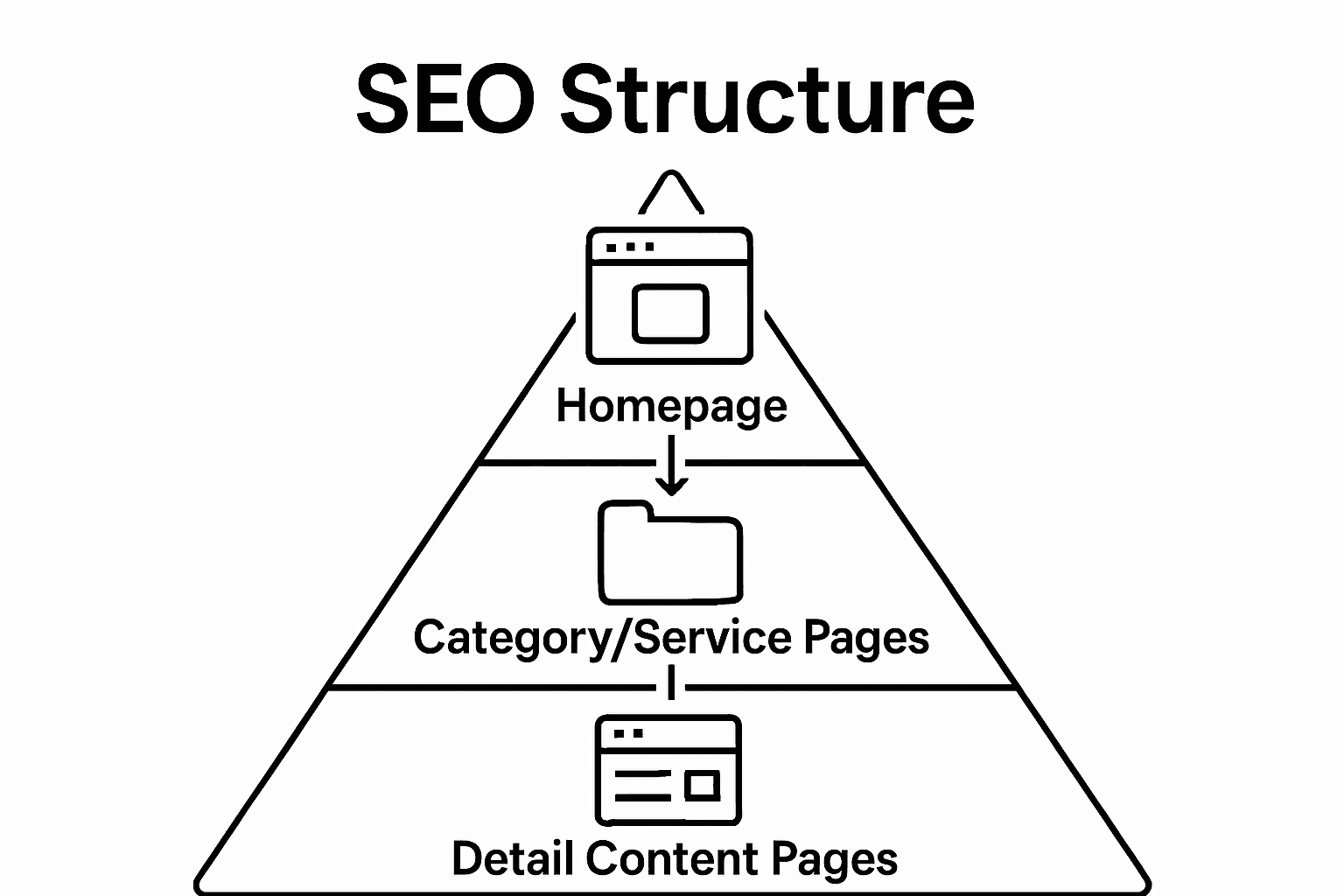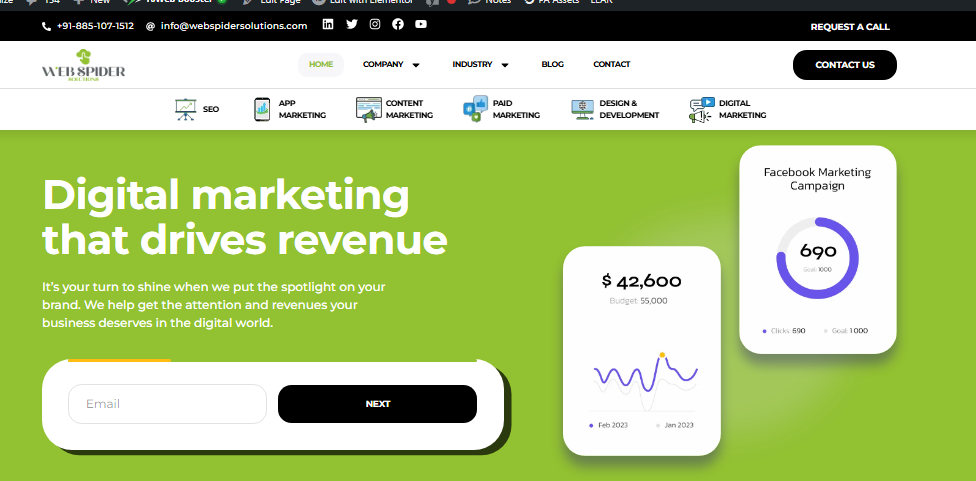Website structure sounds simple at first. Every page in the right place, every menu making sense. But did you know that websites with transparent, well-organized structures often get preferential treatment from Google’s search results compared to messy competitors? Most people obsess over keywords, yet the real difference makers are often the hidden frameworks shaping your whole site’s SEO performance.
Table of Contents
- What Is Website Structure And Why Is It Important For SEO?
- Key Components Of An Effective Website Structure
- How Website Structure Influences Search Engine Rankings
- Best Practices For Optimizing Website Structure For SEO
Quick Summary
| Takeaway | Explanation |
|---|---|
| Optimize URL Structure | Use clean, descriptive URLs to enhance content organization and improve SEO. |
| Implement Internal Linking | Create strategic connections between related pages to boost crawlability and user navigation. |
| Establish Clear Hierarchical Organization | Design your website’s structure in a pyramid model to ensure intuitive user journeys and better search understanding. |
| Utilize Technical Navigation Elements | Incorporate XML sitemaps, breadcrumb navigation, and canonical tags to improve user experience and indexing. |
| Monitor and Refine Performance | Regularly analyze user metrics and adjust structure to adapt to changes in SEO requirements and user behavior. |
What is Website Structure and Why is it Important for SEO?
Website structure represents the organized arrangement of web pages, content, and navigational elements that define how information is presented and interconnected within a digital platform. At its core, website structure determines how search engines and users comprehend, explore, and interact with online content. Learn more about SEO fundamentals to understand this critical digital strategy.
The Fundamental Components of Website Structure
A well-designed website structure includes several key architectural elements that collectively influence search engine optimization and user experience. These components work together to create a logical, intuitive digital environment
Below is a table summarizing the fundamental components of website structure for quick reference and clearer understanding.
| Component | Description |
|---|---|
| URL Hierarchy | Clean, descriptive URL paths reflecting content organization |
| Navigation Menus | Logical menus enabling seamless movement across site pages |
| Internal Linking | Strategic links connecting related content pages |
| Sitemap | Blueprint listing all website pages for search engine indexing |
| : |
- URL Hierarchy: Clean, descriptive URL paths that reflect content organization
- Navigation Menus: Logical menu systems enabling seamless user movement
- Internal Linking: Strategic connections between related content pages
- Sitemap: Comprehensive blueprint of all website pages for search engine indexing
Why Search Engines Care About Website Structure
Search engines like Google utilize sophisticated algorithms that assess website structure as a critical ranking factor. A clear, logical structure helps search engine crawlers efficiently understand and index content. According to Google’s Search Quality Evaluator Guidelines, websites with transparent, well-organized structures receive preferential treatment in search results.
The structural integrity of a website directly impacts its SEO performance through several mechanisms:
- Improved crawlability and indexing efficiency
- Enhanced user experience and reduced bounce rates
- Clear content categorization and topical relevance
- Faster page loading and better performance signals
Effective website structure transforms your digital platform from a collection of random pages into a coherent, interconnected ecosystem that serves both user needs and search engine requirements. By prioritizing intelligent design and strategic organization, businesses can significantly improve their online visibility and user engagement.
Key Components of an Effective Website Structure
Building a robust website structure requires strategic planning and understanding of how different architectural elements interact to create a seamless digital experience. Explore our guide on developing website content to complement your structural strategy.
Hierarchical Page Organization
A strategic website structure establishes clear hierarchical relationships between pages, ensuring logical content categorization. This organizational approach helps both users and search engines navigate complex websites efficiently. The hierarchy typically follows a pyramid model where:

- Top Level: Homepage and primary category pages
- Second Level: Subcategory and primary service/product pages
- Third Level: Detailed content pages, blog posts, specific product descriptions
Proper hierarchical design enables intuitive user journeys and supports search engine understanding of content relationships.

Technical Navigation Elements
Technical navigation components play a critical role in establishing an effective website structure. These elements go beyond visual menus and include backend configurations that enhance crawlability and user experience.
The following table highlights the key technical navigation elements and their purposes as described in the article.
| Technical Element | Purpose |
|---|---|
| XML Sitemaps | Provide a complete inventory of pages for search engine indexing |
| Canonical Tags | Resolve duplicate content issues |
| Breadcrumb Navigation | Show precise content location within the site hierarchy |
| Semantic HTML Structure | Use headings and schema markup for improved content understanding |
| According to Moz’s Technical SEO Guide, key technical navigation elements include: |
- XML Sitemaps: Comprehensive page inventories for search engine indexing
- Canonical Tags: Resolving duplicate content issues
- Breadcrumb Navigation: Displaying precise content location within site hierarchy
- Semantic HTML Structure: Using appropriate heading tags and schema markup
Scalable and Flexible Architecture
An exceptional website structure anticipates future growth and adaptability. Flexible architecture allows seamless content expansion without compromising existing navigational integrity. This approach involves creating modular design frameworks that can accommodate new pages, services, or product lines without requiring complete structural redesigns. By maintaining a clean, logical URL structure and implementing consistent categorization principles, websites can evolve dynamically while preserving optimal SEO performance and user experience.
How Website Structure Influences Search Engine Rankings
Learn about the latest SEO ranking factors to understand the comprehensive impact of website architecture on digital visibility. Website structure serves as a critical determinant in how search engines evaluate and rank web content, acting as an invisible framework that directly influences search performance.
Crawlability and Indexing Efficiency
Search engine crawlers utilize sophisticated algorithms to navigate and understand website structures. A well-organized site enables these digital explorers to efficiently map content, determining relevance and ranking potential. According to Google’s Search Central Documentation, websites with clear, logical structures receive preferential treatment in search results.
Key aspects of crawlability include:
- Logical URL Pathways: Clean, descriptive URLs that reflect content hierarchy
- Internal Linking: Strategic connections between related content pages
- Minimal Crawl Depth: Ensuring important pages are accessible within few clicks
Content Relevance and Semantic Connections
Website structure plays a pivotal role in demonstrating topical authority and content relationships. Search engines analyze how different pages interconnect, assessing the comprehensiveness and depth of information across a digital platform. A strategic structure helps search algorithms understand:
- Thematic clusters of related content
- Hierarchy of information importance
- Contextual relationships between different pages
Performance and User Experience Signals
Modern search ranking algorithms increasingly consider user experience as a critical ranking factor. Website structure directly impacts key performance metrics that search engines monitor:
- Page load speed
- Navigation ease
- Mobile responsiveness
- User engagement and interaction patterns
By creating an intuitive, well-organized website structure, businesses can simultaneously improve search engine rankings and user satisfaction, transforming technical architecture into a powerful SEO strategy.
Best Practices for Optimizing Website Structure for SEO
Explore our comprehensive site architecture guide to unlock advanced SEO optimization strategies. Implementing effective website structure requires a holistic approach that balances technical precision with user-centric design principles.
Strategic Information Architecture
Information architecture forms the foundation of an SEO-friendly website structure. This approach involves systematically organizing content to maximize both user experience and search engine comprehension. According to Nielsen Norman Group’s Research, effective information architecture reduces user cognitive load and improves content discoverability.
Key strategic considerations include:
- Content Clustering: Grouping related topics and themes
- Logical Taxonomies: Creating clear, intuitive content categories
- Consistent Navigation Patterns: Maintaining uniform user interaction models
Technical Optimization Techniques
Technical optimization transcends basic structural design, involving sophisticated approaches to enhance website crawlability and indexing. Successful implementation requires attention to multiple technical elements that signal content quality and relevance to search engines:
- Clean URL Structures: Implementing descriptive, keyword-relevant URLs
- Comprehensive Internal Linking: Creating semantic connections between pages
- Schema Markup Implementation: Providing structured data for enhanced understanding
- Mobile-First Responsive Design: Ensuring seamless cross-device experiences
Continuous Performance Monitoring
Optimizing website structure is an iterative process that demands ongoing evaluation and refinement. Digital landscapes evolve rapidly, necessitating consistent performance tracking and strategic adjustments. Regular audits help identify potential structural weaknesses, navigation challenges, and opportunities for improvement.
Effective monitoring involves:
- Analyzing user behavior metrics
- Tracking search engine crawl performance
- Identifying and resolving navigation bottlenecks
- Adapting to emerging search algorithm requirements
By adopting a proactive, comprehensive approach to website structure optimization, businesses can create robust digital platforms that simultaneously satisfy user needs and search engine requirements.
Transform Your Website Structure Into an SEO Growth Engine
Struggling to make search engines understand your content or frustrated by low rankings despite quality web pages? If you want your business to thrive in search results, your website structure is not something to overlook. The article highlighted how a clear hierarchy, smart internal linking, and technical navigation create the backbone of SEO success. But turning this strategy into reality can be complex, especially for businesses aiming for both visibility and lasting impact. Explore more proven strategies in our Uncategorized Archives, where we address common pain points for growing brands.

Ready to remove confusion and unlock your site’s true potential? Now is the moment to act. Visit Web Spider Solutions to connect with experts who specialize in optimizing website structure for better search performance and user experience. Discover how thoughtful organization and technical precision can drive more traffic and targeted leads to your business. Your path to higher rankings and stronger digital growth starts today.
Frequently Asked Questions
What is website structure in the context of SEO?
Website structure refers to the organized arrangement of web pages, content, and navigational elements of a website, influencing how search engines and users interact with the information.
Why is website structure important for SEO?
A well-structured website improves crawlability for search engines, enhances user experience, reduces bounce rates, and helps in categorizing content clearly, all of which are crucial for better search engine rankings.
What are the key components of effective website structure?
Key components include a logical URL hierarchy, intuitive navigation menus, internal linking strategies, and the use of sitemaps to guide search engines in indexing the site.
How can website structure affect user experience?
A clear and logical website structure allows users to navigate easily, find relevant content quickly, and engage with the site more effectively, ultimately leading to higher satisfaction and lower bounce rates.
Recommended











